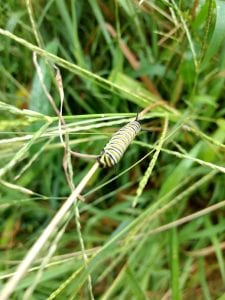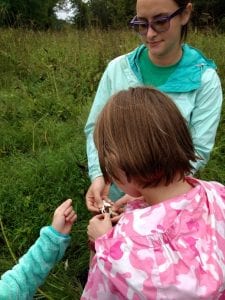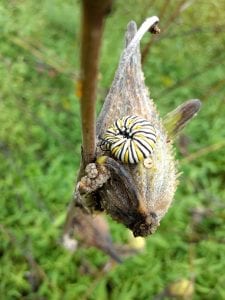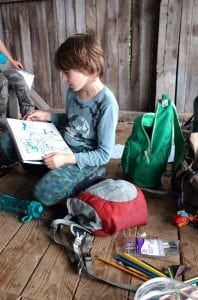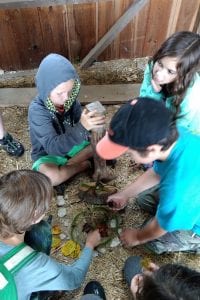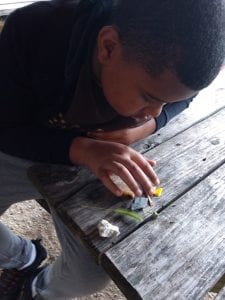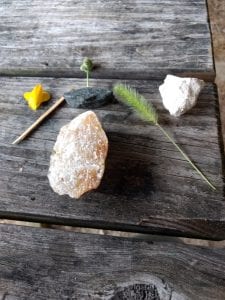9/11/2018
Welcome to our Fall session of Art & Science of the Land, where we learn more about land artists, create art installations out of natural materials, and spark our own curiosity and explore our connection to the land. Before we learn about how others have expressed their love of nature by creating works of art, it is important for all of us to find our own personal link to the land and nature. What inspires us? What do we love about nature and being outside? What are some of our favorite memories of outdoor play? Without creating a foundation of love, caring and compassion for nature and its creatures, the art of creating won’t be as potent. Fostering that connection is what motivates people to want to preserve and protect the planet, its natural resources and animals, it’s what creates nature ambassadors.
Today we started with a walk down the Vista Loop Trail, being immersed in the early fall weather, the smell of the decaying leaves, the cool nip in the air, the sounds of animals as they prepare for the cold months ahead. At the gazebo we enjoyed snack and discussed some of our intentions for the class. How do we intend to act and what do we hope to get out of the class? After brainstorming as a group and writing down our intentions in our journals, here is what we decided on: Listen while others are talking, stay with the group and within eyesight of an adult, be kind and respectful to each other and nature and have fun! After our intentions were put in writing we talked a bit about the goals and theme of the class and brainstormed some nature art sculptures we have seen before. Some examples we listed were of pottery being made into shapes of people, picture frames hanging in nature and others. Before venturing out we looked at our Irvine map to see where we were and where we wanted to go. The first day of class is always an introduction to Irvine, its trails, and some of its special places (like the Gazebo). We decided to head out into the meadow to see what we could find (identifying the meadow name on the map, too).
This time of the year is the perfect time to look for Monarch Butterflies. We walked out into the Pollinator Meadow to see what we could find. Barely walking a few feet off the trail we found a couple monarch butterfly caterpillars and a chrysalis hanging from a milkweed stem. We collected the caterpillars to take back to be raised at Irvine so they could be released as adult monarchs to have the best chance of survival on their journey to Mexico. We also broke open a green milkweed pod that had already fallen off to explore the inside. The milkweed pods are ready to burst open when they turn brown and dry and the seeds inside rae brown and the fluffy material is open and dry. The inside felt wet and a bit slimy and mushy and the seeds weren’t ready and were tightly compacted.
At the Ed Hut we took a break to eat snack and do a “get to know you” journaling activity. We divided a journal page into four sections with a circle in the center. Inside the circle we wrote our name and something interesting about ourselves, like our favorite food or animal. In the corners we were to draw at least 2 of our favorite outdoor/nature activities and then we could draw something else that represented us in the other boxes. Once we were done we shared our journals with the group so everyone could get to know us a bit better. Here are some of the favorite things we shared: climbing and planting trees, rope courses, walking our dog, swinging on a swing, cats, electronic music, swim team, Irvine, writing in our journal, Harry Potter, riding bikes, swimming at the beach and playing in the meadow.
With the day nearing an end, we grabbed our maps and reoriented ourselves and headed to the barn. At the barn we explored the trails we had walked on so far and prepared for our first nature art installation. We had a few minutes to go off on our own and collect at least 5 different nature materials we could find on the ground and we were allowed to pick one of the items from a plant. Some of the materials we collected were fuzzy grass tops, sticks, rocks, a few flower petals, larger pieces of wood, and leaves. Some of us built our own individual art sculptures before compiling all of our nature materials into one large sculpture. In the end our sculpture represented a campfire.
This fall we will be learning about various land artists and why land art is used as a form of expression and education. We’ll be creating our own land art and learning how some land art, sculptures and structures can even change the land itself. We also hope that through our exploration, art expressions and being outside in nature we will be able to foster a new appreciation and care for the plants and animals that we share our planet with.
